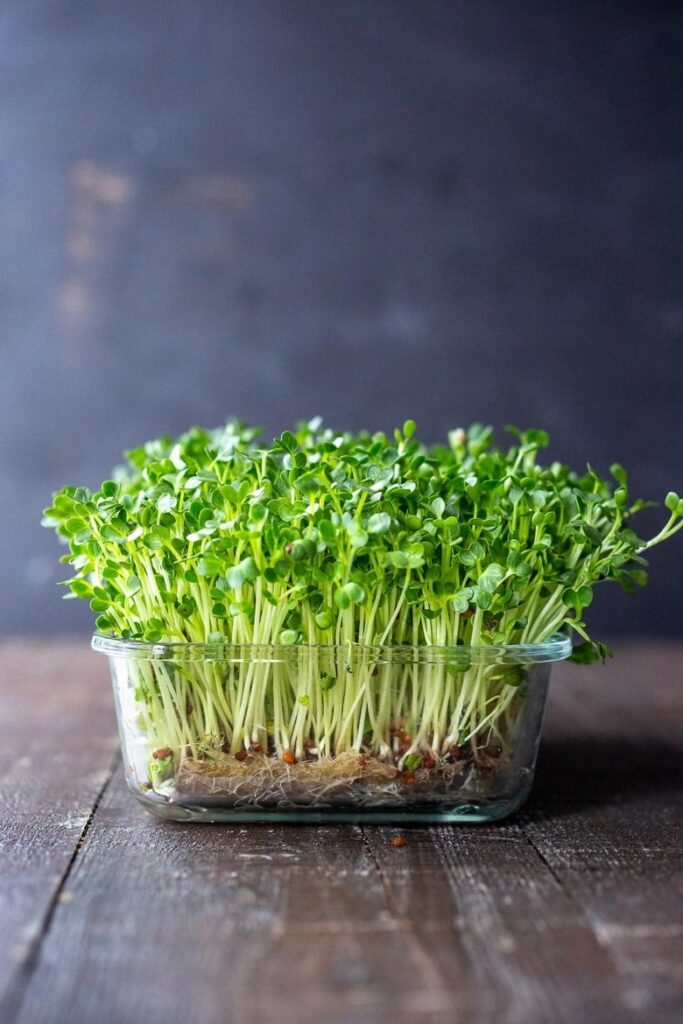To make Microgreens, you will need seed, a shallow container, soil or a soilless medium, and a way to water them. First, prepare the container with soil, spread seeds evenly, lightly cover them with soil, and water gently. Keep the soil moist and provide light. After a week or so, they’ll be ready to harvest.
1. Gather your supplies:
- Seeds: Choose your desired seeds. Popular options include broccoli, radish, kale, and mustard. En
 sure they are organically certified or untreated
sure they are organically certified or untreated
- Container: Shallow trays or containers with drainage holes are ideal. You can also use a second tray without holes to catch excess water.
- Growing Medium: Use a seed-starting mix or a soilless medium like coco coir.
- Watering: A spray bottle or watering can work well for gentle watering.
- Light: Microgreens need light to grow. A sunny windowsill or grow lights are good options.
2. Prepare the container:
- Fill the container with about 1-2 inches of soil.

- Moisten the soil with water.
3. Seed selection:
- Broccoli seeds
- kale seeds
- peas
- arugula
- radish or spicy radish
- amaranth
- chia
- mustard
- beet
- buckwheat
- chard
- cabbage
- cilantro
- fenugreek
- basil – opal basil is pretty
4. Sow the seeds:
- Spread seeds evenly over the soil surface.
- For smaller seeds, you can sprinkle them densely. For larger seeds like peas, you might need to soak them beforehand and space them out more.
- Lightly cover the seeds with a thin layer of soil.
5. Water and care:
- Water gently with a spray bottle or watering can to keep the soil moist but not水logged.
- Cover the container with a lid or plastic wrap during the germination period (2-5 days) to maintain humidity, or use a second tray to create a dark environment.
- Once seeds germinate, remove the cover and place the container in a location with indirect sunlight or under grow lights.
- Water regularly, keeping the soil moist but not we
6. Harvest:
- Microgreens are typically ready to harvest in 7-21 days, depending on the variety.
- Harvest when the true leaves begin to appear (the second set of leaves after the cotyledons).
- Cut the microgreens with scissors just above the soil line.
- Rinse and enjoy.
7. Here’s a closer look at the benefits:
-
Rich in Nutrients:Microgreens are packed with vitamins (A, C, E, and K) and minerals (calcium, magnesium, iron, zinc, and potassium). Some studies show they can contain up to 40 times more nutrients than mature plants.
-
Antioxidant Powerhouse:They are a good source of antioxidants like polyphenols, which help protect against cell damage from free radicals and reduce inflammation.
- Support Heart Health: The antioxidants and nutrients in microgreens, particularly polyphenols, can help lower LDL (bad) cholesterol and triglyceride levels, potentially reducing the risk of heart disease.
-
May Reduce Cancer Risk:Certain microgreens, like broccoli, contain sulforaphane, which has been linked to a lower risk of certain cancers.
-
Promote Digestive Health:Microgreens are a good source of dietary fiber, which can aid digestion, promote regular bowel movements, and support a healthy gut microbiome.
- Potential Anti-inflammatory Properties: The antioxidants and other bioactive compounds in microgreens may help reduce inflammation in the body.
- Versatile in Cuisine: Microgreens can be added to salads, sandwiches, soups, and various other dishes, adding flavor, texture, and nutritional value.
different types of microgreens offer different nutrient profiles, so it’s beneficial to consume a variety of them.
Broccoli sprouts are one of the most nutrient-dense microgreens. They are full of glucoraphanin and sulforaphane which are known to prevent cancer. They are highest in minerals and vitamins.
8. 10 Health Benefits of Microgreens (Broccoli Sprouts)
- Cancer-Fighting Many microgreens, especially broccoli, contain high levels of sulforaphane, which research shows inhibits the growth of cancer cells.
- Prevents chronic disease. Microgreens have many health-promoting micronutrients to help stave off major diseases.
- High in Minerals. Microgreens have larger quantities of minerals than their vegetable counterpart.
- High in Antioxidants.
- May lower cholesterol
- 40 times more nutrients than their mature plant counterpart.
- Helps with weight management
- Microgreens are considered a prebiotic which feeds good bacteria in the gut.
- Possibly lowers blood pressure
- High in Vitamins A, Beta Carotene, C, E, K and Lutein.
9. Ways to use Microgreens
- Use on soups for a bright pop of color! Curried Cauliflower Soup
- Use on Buddha bowls: Our best Buddha Bowls!
- Use on salads: 40 Must-Try Vegan Salads
- Add to sandwiches and wraps!
Growing microgreens is truly very simple and easy! Such a joyful thing to do in winter when we all could use a little pick-me-up.
Give them a try and enjoy all the flavor and health benefits they bring.


